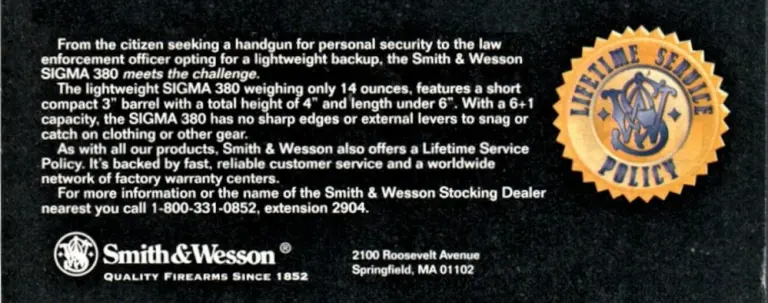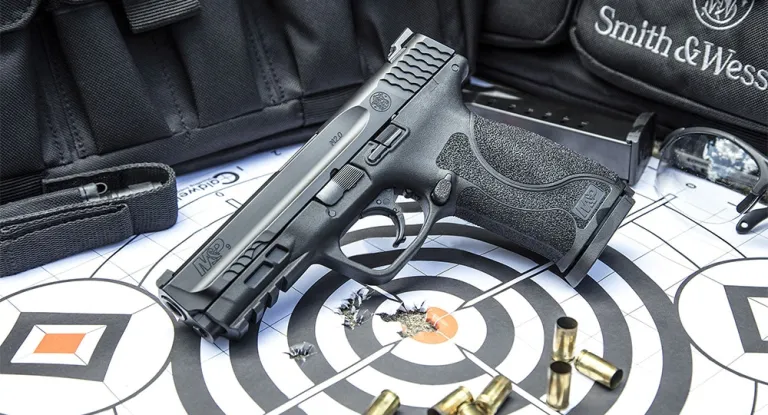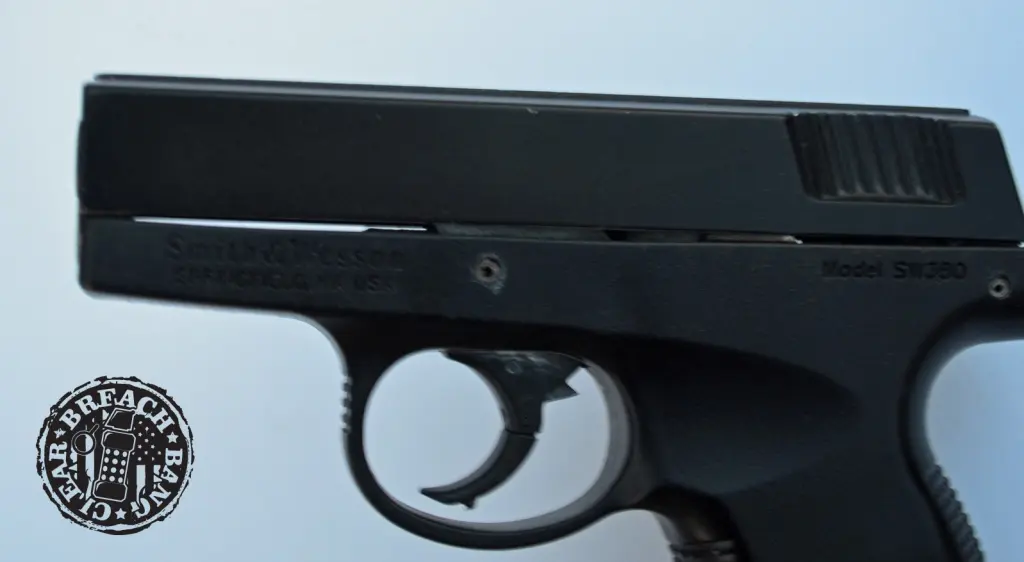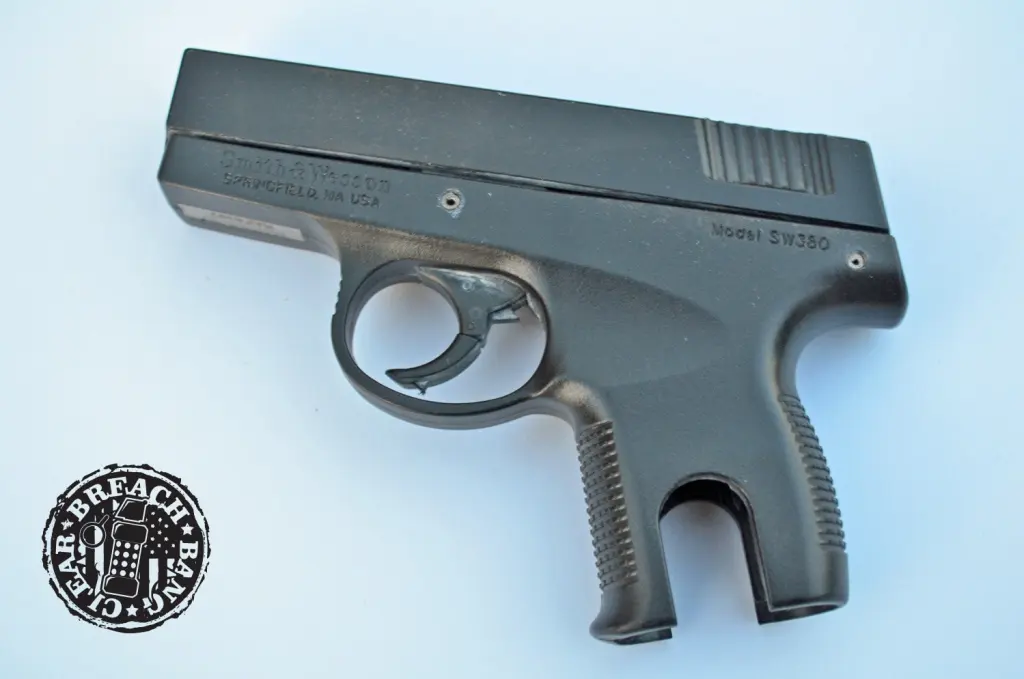SMITH's SIGMA/SW380
Forgotten pocket pistol that should stay that way
Today we'll look at Smith & Wesson's first pistol chambered in .380 ACP. Better known as the SW380, this little polymer framed pistol was produced for about eighteen months before it faded into obscurity.

Sometimes, a weapon disappearing into history is a good thing — and we don't say that because of any .380 vs. 9mm nonsense, either.
S&W Sigma Series
SW380 History
The Sigma series was Smith & Wesson's first foray into polymer-framed pistols. These striker-fired models were a huge departure for the company, whose history was steeped in cartridge revolvers and metal framed hammer fired pistols.

Introduced in 1994, they were initially chambered in 9mm and .40 S&W. The were designed for simplicity and economy and were in fact extremely similar to Glock's pistols. They were so close in fact that Glock took them to court. However, after a number of lawsuits and cash settlements, Smith & Wesson somehow prevailed.
Keep in mind that a lot was happening in 1994. The Federal Assault Weapon Ban limited magazine size to ten rounds or less for civilians, but at the same time Concealed Carry Reform was on the rise in many states. With the limitation on capacity and the demand for smaller pistols, more companies started making small pistols in larger calibers as well as concealable “pocket autos.”

In 1995 S&W introduced their small concealed-carry style Sigma variant. The SW380, chambered in .380 ACP, held six rounds and was fitted with very rudimentary “guttersnipe” sights. It had a single-stack magazine and a large thumb cut-out in the base of the frame, to supposedly make magazine removal easier.

SW.380 Design
Based on the lines of the Sigma, this was actually the only model we ever liked at first sight. Despite being diehard S&W collectors, it was the only one we ever bought. We even remarked how it looked like a “Tiny Glock” and hoped they would make one someday.

That is where the similarity ends.
The SW380 is a straight blowback pistol with a slide made of a zinc alloy known as Zamak. Many of us see this alloy as junk, but it's probably enough for a small-caliber pistol. Disassembly involves removing a roll pin in the slide. MSRP was around $300, with street prices of $220 to $250. It was plain to see to whom S&W was marketing these pistols: the reluctant gun owner who wanted something inexpensive and would only fire an occasional magazine or two over the years. S&W admitted the service life was about 2500 rounds.

You may be wondering why we would look at such a firearm like this, but the reason is simple. Numerous law enforcement officers and shooters who trusted the Smith & Wesson name for years bought these pistols based on the name. The sights were reminiscent of those found on the custom ASP and Devel pistols of only a few decades previous. People simply thought they were buying quality. But its numerous issues and poor sales led it to being dropped from production in 1996.
Guttersnipe Sights
Guttersnipe sights, or just “gutter sights” have been around for more than a century (at least). Just not necessarily by that name. For instance, FN's Model 1910 (a Browning design) used a milled channel down the slide. During the Cold War, a company called Armament Systems and Procedures (ASP) designed a interesting little “spook” or “spy” pocket gun. The ASP pistol was based on the S&W Model 39 and featured what have now become known across many a platform as guttersnipes.
The ASP's sighting system was revolutionary. Theodore's patented sight, called the Guttersnipe, consisted of a machined block of steel with a tapered channel that ran longitudinally. The sides and bottom of the sight channel were painted yellow for high visibility. There was no front sight. The Guttersnipe required the shooter to subconsciously balance the yellow panels on the sides and bottom of the channel to align the ASP properly. In practice, the Guttersnipe was extremely fast to acquire and was “battle” accurate. Rob Garrett, Guns America
SW380 Function
Our SW380 has admittedly given us just a few problems. We picked it up cheap for perhaps the only other reason someone should even consider this piece: to fill a void in the S&W collection.
It is a semi-interesting piece and there are some neat features to the SW380, such as the grasping grooves at the rear of the slide to aid in racking. The trigger safety and firing pin safety are scaled-down versions of those used on full-size pistols.
The magazine release on the magazine's base pad reminds us more of charging a cordless drill than loading or unloading a pistol. While this feature is well-intentioned, it's our biggest issue with the pistol after the cheap materials and short service life. It simply takes too long to remove the magazine.


Over the years Smith committed more dick-stepping maneuvers with the infamous “Clinton Agreement. They quickly went to “least favored firearms company” by most Second Amendment supporters.
Thankfully a good CEO took the company back and righted the ship. That agreement is now a dark footnote in history and the Sigma line eventually evolved into the M&P series. But if you see one of these twenty-plus-year-old plastic pocket pistols and think it might be a good backup piece or even primary carry piece, stay away.
Read the original article in its entirety at Breach Bang Clear.


